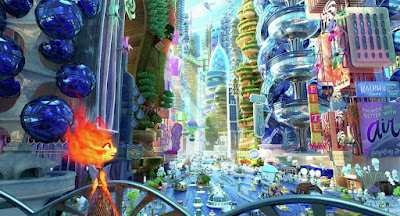Elemental (Peter Sohn, 2023) We will try to keep this review as pun-free as possible as Pixar's latest release seems to be doing somersaults trying to use every paronomasia to the four classical elements—Earth, Air, Fire and Water—as it possibly can within its slim 100 minute length (including the voluminous Pixar end-credits). The film is so crowded and over-stuffed that one should be glad they stuck with the Empedocles-ian list and tabled the other 118 (and, see, there I go).
It resembles Disney's Zootopia in that it posits a multi-cultural world in which there are segregated zones for the disparate groups of Earth-people, the Vapors, the Combustibles, and Those Who Go with the Flow within Elemental City, a construct that seems to have been made just for such a purpose, as things tend to melt, flow, slide, and burn when the four basics collide and exchange energy.
"Who knows?"
There's an amusing little moment when the two main characters, fiery Ember Lumen (Leah Lewis) and watery Wade Ripple (Mamoudou Athie) both walk through a chain-link fence—him gushing through and her melting it—where they muse "Why do they even have these?" "Who knows?" Indeed, in a society, however segregated, where barriers serve no purpose to mutual self-interest, what's the point? But, it's just a moment—an aside—that resonates within the bigger context of the movie's intentions.
And that is to show the "immigrant experience" in a film where that will serve as backdrop for the main relationship between Ember and Wade—a sort of "Wet Side Story" if you will (and I wouldn't blame you if you didn't).
Ember comes from the immigrant family of Bernie (Ronnie Del Carmen) and Cinder (Shila Ommi)—two anglicized names they got when they entered Element City—who left their home island of Fireland for a better life, and who met resistance from moving into the wooden structures of the Earth area (fire danger!) and the Water sector (they'll evaporate the place!) and settled for a walk-up from the bodega they've found in order to make a living and serve the community. Their daughter, Ember, learns the ropes of minding the store, with the aim of taking over the place when the Old Man retires.
But, she has anger-management issues, which turns into a burning purple rage, when dealing obstinate customers. One of those hissy fits results in a broken pipe in the basement, which floods it, dropping Wade, a city inspector, into the mix. Wade is a bit of a sensitive soul, given to crying jags, naturally, so he is distressed to find out that the Lumen store isn't exactly up to code and must report it for multiple violations putting the business in jeopardy of being shut down. This puts him at odds with Ember, who is determined to save the store at all costs.
Though seemingly polar opposites, in nature and purposes, the two become close in their efforts—her to save the store and him to find out why Elemental City seems to be in danger of an infrastructure defect that could threaten to flood the Fire district—even as they know that any sort of relationship could mean...well, extinction or extinguishment for one or both of them. They can't help their natures, but their nature is also to be attracted to each other.
This is a different kind of Pixar movie for a number of reasons. One is that the story takes on the tropes of a film genre that the studio has never partaken before, that of the rom-com. It follows the basic steps—the meet-cute, the diametric odds, the mutual interest, the separating complication, and the final emotional epiphany that resolves all issues until the final fade-out, which leaves everyone in a soggy after-glow that assumes nothing else will compromise the happy ending. Elemental is not immune to such step-by-step manipulation, even if the characters are mere concepts rather than attractive B-listers for Hallmark. It's still a little phony and a lot trite.
The other thing is that although the backgrounds are the same Pixar magic we've come to expect and take for granted, the characters...are concepts, not some animated anthropomorphic projection of identifiable species, more of the type of animation done in the analog 2-D days. Pixar did much the same thing with their animated emotional traits in Inside Out, but they were off-set by more relatable characters in the enveloping story. There is just that couple of degrees of animated "otherness" that keeps one becoming wholly invested in the story.
Still, there are moments; there always are with Pixar, even with their handful of sub-par—and that "par" is very high—releases. There are moments that pay off quite well, even if one feels that the extra polish the film-makers usually do to nail the things feels missing.










No comments:
Post a Comment